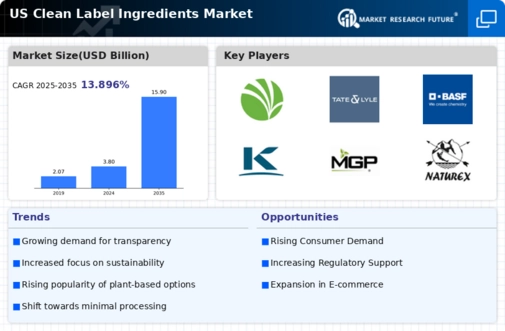Consumer Health Consciousness
The rising awareness of health and wellness among consumers is a pivotal driver for the clean label-ingredients market. As individuals increasingly prioritize their health, they tend to scrutinize food labels more closely, seeking products that contain natural and recognizable ingredients. This trend is reflected in market data, which indicates that approximately 70% of consumers in the US are willing to pay a premium for products with clean labels. This shift in consumer behavior compels manufacturers to reformulate their products, ensuring that they align with the growing demand for transparency and healthfulness. Consequently, the clean label-ingredients market is experiencing robust growth, as brands strive to meet these evolving consumer expectations.
Innovation in Food Technology
Advancements in food technology are playing a crucial role in the evolution of the clean label-ingredients market. Innovations such as natural preservatives and alternative processing methods enable manufacturers to create products that meet clean label standards without compromising on shelf life or taste. For instance, the development of plant-based preservatives has gained traction, allowing brands to maintain product integrity while adhering to clean label principles. This technological progress is essential, as it addresses consumer concerns regarding artificial additives and preservatives. The clean label-ingredients market is thus poised for growth, driven by the continuous innovation that meets both consumer demands and regulatory requirements.
Shift Towards Plant-Based Diets
The growing trend towards plant-based diets is a notable driver for the clean label-ingredients market. As more consumers adopt vegetarian or vegan lifestyles, there is an increasing demand for clean label products that align with these dietary preferences. This shift is reflected in market data, indicating that the plant-based food sector has seen a growth rate of over 20% in recent years. Consumers are actively seeking products that are not only plant-based but also free from artificial ingredients and additives. Consequently, manufacturers are reformulating their offerings to cater to this demographic, thereby propelling the clean label-ingredients market forward.
Regulatory Changes and Compliance
Regulatory frameworks surrounding food labeling are evolving, impacting the clean label-ingredients market significantly. In the US, agencies such as the FDA are increasingly emphasizing the need for transparency in food labeling, which compels manufacturers to adopt clean label practices. Compliance with these regulations not only ensures consumer safety but also enhances brand credibility. As a result, companies are investing in clean label formulations to meet these regulatory standards, which is likely to drive market growth. The clean label-ingredients market is thus influenced by the necessity for compliance, as brands strive to align their products with the latest labeling requirements.
Sustainability and Ethical Sourcing
Sustainability has emerged as a critical concern for consumers, influencing their purchasing decisions significantly. The clean label-ingredients market is increasingly shaped by the demand for ethically sourced and environmentally friendly ingredients. Many consumers are now inclined to choose products that not only promote health but also reflect their values regarding sustainability. Market Research Future suggests that around 60% of US consumers consider sustainability when making food choices. This trend encourages manufacturers to adopt sustainable practices, such as sourcing ingredients from local farms or using organic materials, thereby enhancing their product appeal. As a result, the clean label-ingredients market is likely to expand as brands align with these ethical considerations.




















Leave a Comment